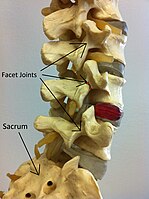
Photo from wikipedia
Background/Objective Atlantoaxial fusion procedures may be difficult in situations such as high-riding vertebral artery, a narrow C2 pedicle, and the presence of ponticulus posticus–arcuate foramen. With respect to vertebral artery… Click to show full abstract
Background/Objective Atlantoaxial fusion procedures may be difficult in situations such as high-riding vertebral artery, a narrow C2 pedicle, and the presence of ponticulus posticus–arcuate foramen. With respect to vertebral artery (VA) anomalies, persistent first intersegmental artery, extracranial origin of the posterior inferior cerebellar artery at the C1–C2 level, and fenestration of the VA are all major risk factors for VA injury in C1–C2 fusion surgeries. Methods To safeguard the VA, we designed the unilateral fusion procedure (all screws lie in the ipsilateral side, either the right side or left side): a unilateral transarticular screw combined with an ipsilateral-side C1 posterior arch screw and a C2 laminar screw (LS), with both C1–C2 screws inserted from opposite side, although the trajectory will be on the same side. In addition to atlantoaxial stabilization with screws and rod, autograft bony fusion was performed on the same side as modified Brook's procedure and augmented with sublaminar tapping. Results We present a series of 3 cases operated for odontoid fracture with associated high risk for fusion on one side alone. The fact that the chance of VA injury is high in transarticular screw, in lateral mass screw, less in pars screw, and pedicle screw is well known. Alternate screw placement to avoid VA injury would be a posterior arch screw for C1 and laminar screw for C2, which was adopted in our technique. Conclusions We combined a unilateral transarticular screw and modified Brook's procedure with sublaminar tapping for additional augmentation of fusion. We would like to highlight this C1 posterior arch screw as an alternative procedure for atlantoaxial fusion.
Journal Title: World neurosurgery
Year Published: 2020
Link to full text (if available)
Share on Social Media: Sign Up to like & get
recommendations!